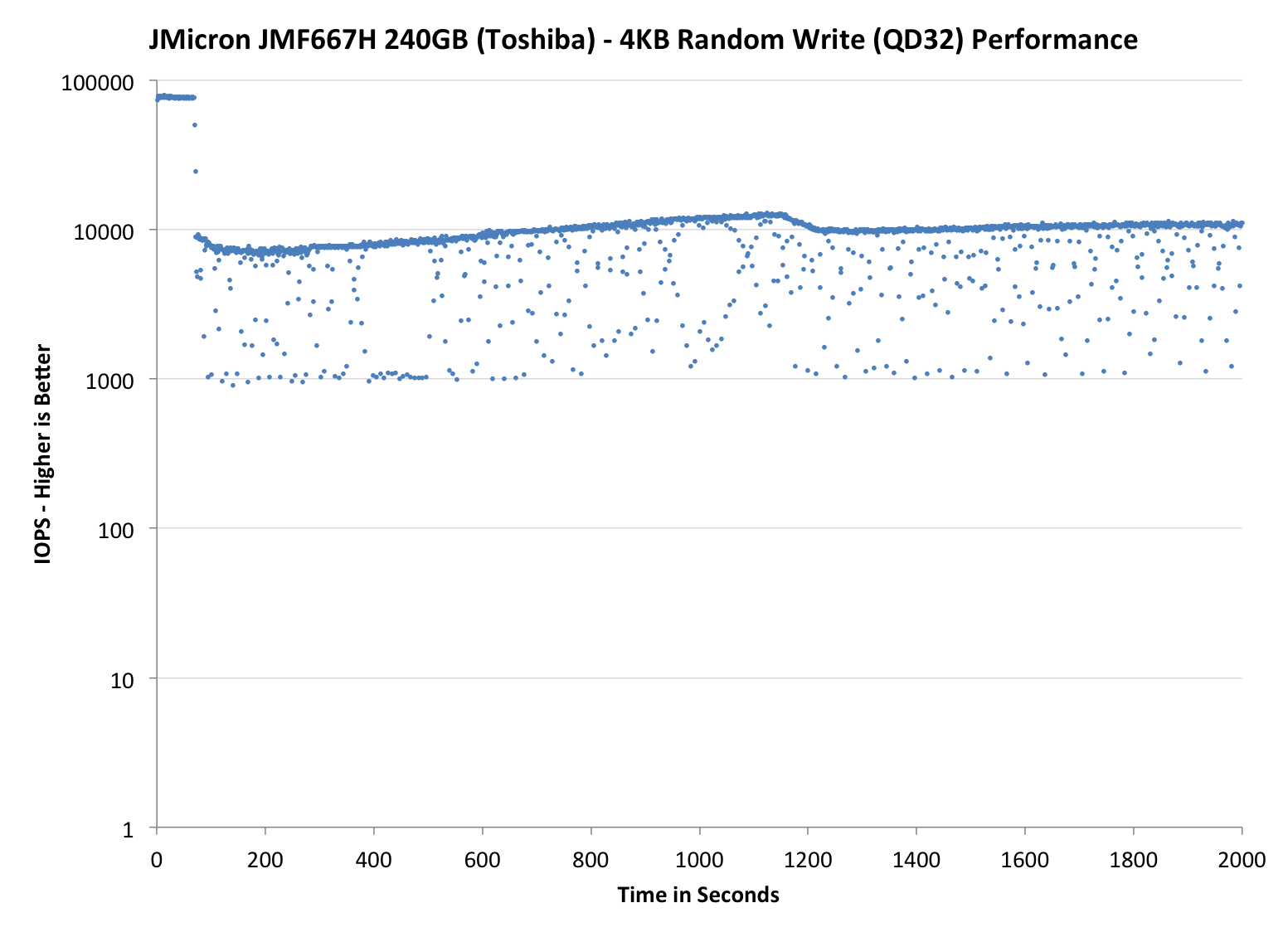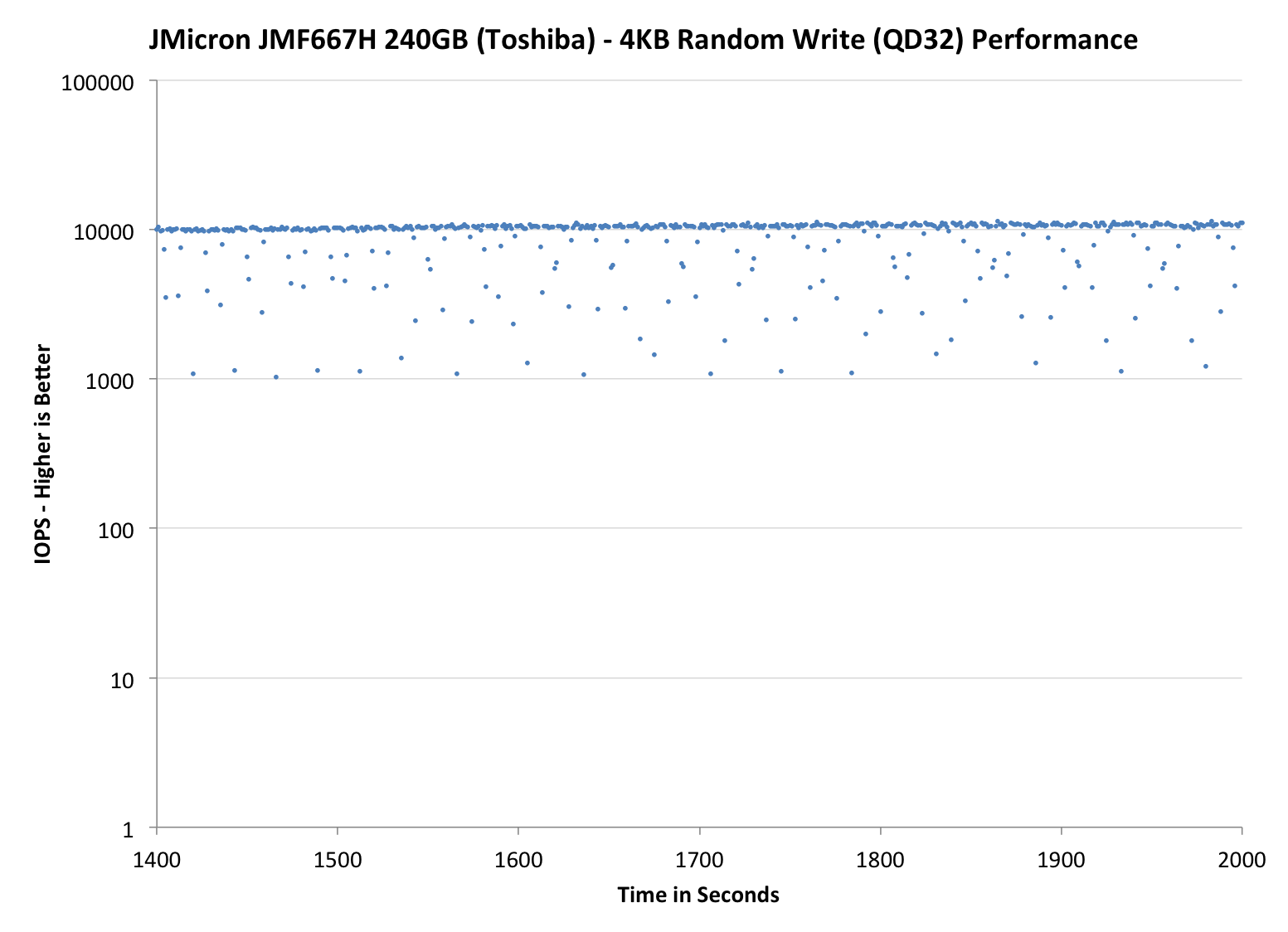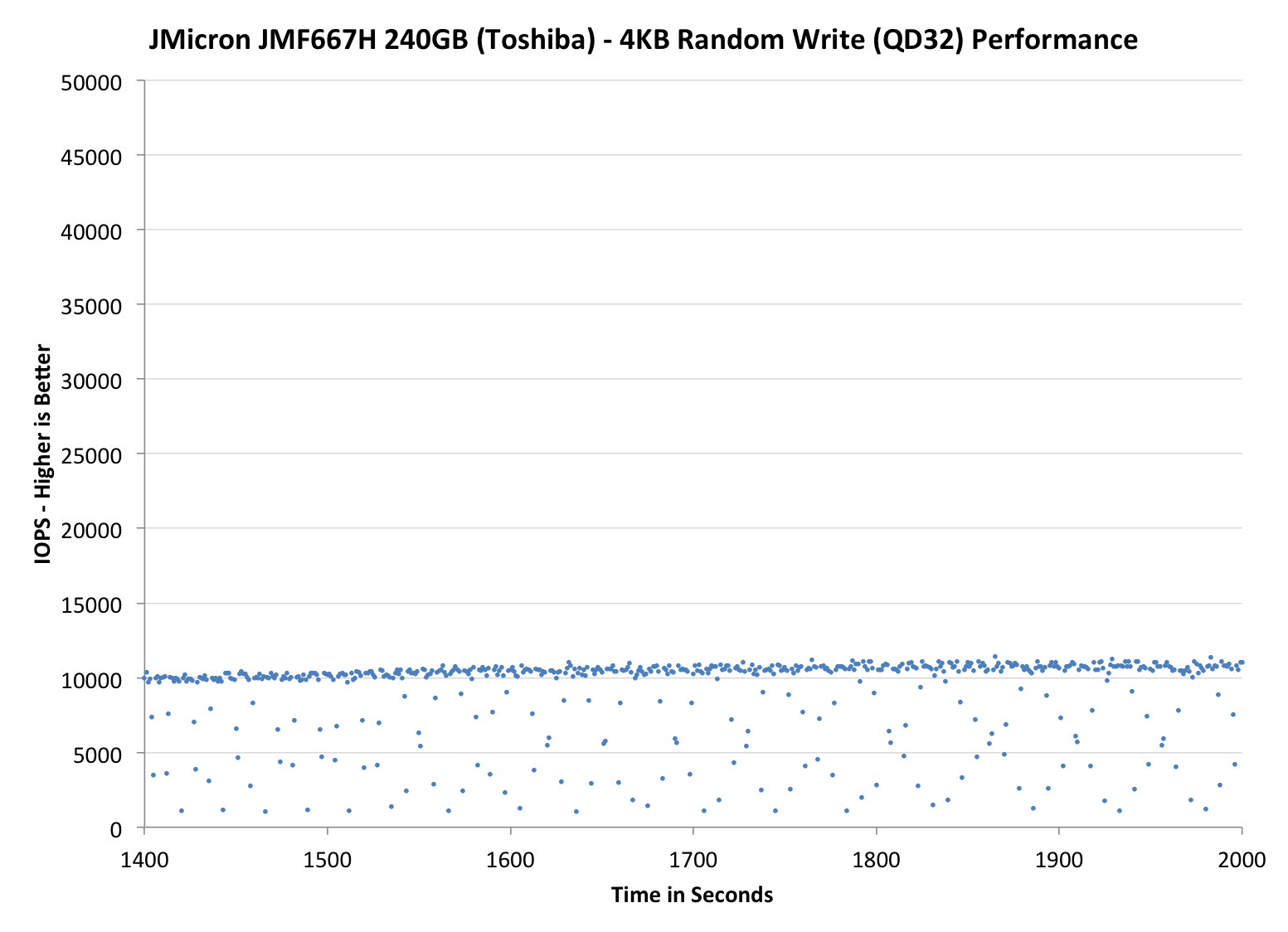JMicron JMF667H Reference Design (128GB & 256GB) Review
by Kristian Vättö on May 29, 2014 9:00 AM ESTPerformance Consistency
Performance consistency tells us a lot about the architecture of these SSDs and how they handle internal defragmentation. The reason we do not have consistent IO latency with SSDs is because inevitably all controllers have to do some amount of defragmentation or garbage collection in order to continue operating at high speeds. When and how an SSD decides to run its defrag or cleanup routines directly impacts the user experience as inconsistent performance results in application slowdowns.
To test IO consistency, we fill a secure erased SSD with sequential data to ensure that all user accessible LBAs have data associated with them. Next we kick off a 4KB random write workload across all LBAs at a queue depth of 32 using incompressible data. The test is run for just over half an hour and we record instantaneous IOPS every second.
We are also testing drives with added over-provisioning by limiting the LBA range. This gives us a look into the drive’s behavior with varying levels of empty space, which is frankly a more realistic approach for client workloads.
Each of the three graphs has its own purpose. The first one is of the whole duration of the test in log scale. The second and third one zoom into the beginning of steady-state operation (t=1400s) but on different scales: the second one uses log scale for easy comparison whereas the third one uses linear scale for better visualization of differences between drives. Click the buttons below each graph to switch the source data.
For more detailed description of the test and why performance consistency matters, read our original Intel SSD DC S3700 article.
 |
|||||||||
| JMicron JMF667H (Toshiba NAND) | JMicron JMF667H (IMFT NAND) | WD Black2 | Samsung SSD 840 EVO mSATA | Crucial M550 | |||||
| Default | |||||||||
| 25% OP | |||||||||
Compared to the WD Black2, there has certainly been improvement in the IO consistency area. When looking at the model equipped with IMFT's NAND (similar to the Black2), the line at ~5,000 IOPS is now much thicker, meaning that more IOs are happening at the 5K range instead of below it. Another big plus is that the IOPS no longer drops to zero, which is something that the Black2 constantly did. The minimum performance is still in the order of a few hundred IOPS, which compared to many competitors is not exactly great, but it is a start.
The model with Toshiba NAND performs substantially better. Even the 128GB model with the same 7% over-provisioning can keep the IOPS at around 3,000 at the lowest. The NAND can certainly have a play in steady-state performance and IO consistency as IMFT's 20nm 128Gbit NAND has twice the pages per block (512 vs 256) compared to Toshiba's A19nm 64Gbit NAND. More pages means that the erase time for each block is longer, which means that the controller may have to wait longer for an empty block. Remember that the drives are effectively doing read-modify-write during steady-state and the longer it takes to erase one block, the lower the performance will be.
It is likely that the drops in performance are caused by this but I am wondering if it's just a matter of poor optimization or something else. Technically it should be possible to achieve a steady line regardless of the NAND as long as the firmware is optimized for the specific NAND. In the end, the block erase times can be predicted pretty well, so with the right algorithms it should be possible to drop the maximum IOPS by a bit to achieve more consistent performance. For a low-end client drive, it is not that significant as the drives are very unlikely to be put under such heavy workload but I think there is still a chance to improve the IO consistency especially in the model with IMFT NAND.
Fortunately there is one easy way to increase IO consistency: over-provisioning. The IO consistency scales pretty well with over-provisioning, although there are still dips in performance that I would not like to see. However, especially the 240GB Toshiba model provides excellent consistency with 25% over-provisioning and beats, for instance, Intel's SSD 530 and SanDisk's Extreme II, which is something I certainly did not expect.
 |
|||||||||
| JMicron JMF667H (Toshiba NAND) | JMicron JMF667H (IMFT NAND) | WD Black2 | Samsung SSD 840 EVO mSATA | Crucial M550 | |||||
| Default | |||||||||
| 25% OP | |||||||||
 |
|||||||||
| JMicron JMF667H (Toshiba NAND) | JMicron JMF667H (IMFT NAND) | WD Black2 | Samsung SSD 840 EVO mSATA | Crucial M550 | |||||
| Default | |||||||||
| 25% OP | |||||||||
TRIM Validation
To test TRIM, I first filled all user-accessible LBAs with sequential data and continued with torturing the drive with 4KB random writes (100% LBA, QD=32) for 30 minutes. After the torture I TRIM'ed the drive (quick format in Windows 7/8) and ran HD Tach to make sure TRIM is functional.
And it is.











28 Comments
View All Comments
Bindibadgi - Friday, May 30, 2014 - link
I'm genuinely wondering if the photos are artistically filtered or simply just that bad??hp79 - Friday, May 30, 2014 - link
I think it's being artistically shot that way. I don't like it either. Photos from AMD article looks fine.Nice article though. Good to see another contender in SSD market, back from the hall of shame.
It's going to be tough though. After sticking a Samsung 840 Pro 256GB in my desktop, and getting a rMBP13 laptop which has proprietary crazy fast SSD, I'm no longer in the market. But if I were to buy another SSD, it'll be whoever is cheapest (after rebates and coupons) with reasonable performance. And it should be a 7mm height so it also fits modern ultra thin laptops, not stupid 9.5mm with no reason.
Kristian Vättö - Friday, May 30, 2014 - link
Better now? I was in a hurry last night as the deadline was approaching way too quickly, so the quality suffered as a result. Bear in mind that we all work from our homes, so the camera equipment and lighting differs greatly from review to review.MrPoletski - Friday, May 30, 2014 - link
For the love of god, why is it that on every SSD review here, every time I look at the performance consistancy graphs it is always for 4KB random write QD32?3 separate tabbed graphs, all saying 4KB random write QD32 - yet clearly only one of them is, the others being perhaps 4kb reads, or 4kb writes QD 1 or 2.
It's this way every time I read an SSD review on anandtech, has nobody noticed this and fixed it yet or what?
MrPoletski - Friday, May 30, 2014 - link
haha, this time there was an explanation in the article. Ok. IGNORE ME LOL.milli - Friday, May 30, 2014 - link
'Micron's roadmaps showed that a SATA 6Gbps JMF66x series was planned for the second half of 2010, which made sense given that Intel was integrating SATA 6Gbps to their 6-series chipsets in early 2011. But for some reason, the JMF66x never made it to the market on time.'I don't think that's entirely true.
The Kingston SSDNow V200 used a JMicron JMF661 or JMF662 controller. That product launched towards the end of 2011 with great difficulties. The controller wasn't broken but the firmware was. It took Kingston six months to release a firmware that fixed the problems. Before that firmware the drive was utterly unusable (paused up to 5 seconds sometimes). After the firmware update it became usable and speed was then as advertised.
You can read about it here: http://forum.notebookreview.com/solid-state-drives...
This was very weird because the JMF618 found in some Kingston drives, worked very well (as found in Anand's reviews).
As for the JMF667H, I've used two Transcend SSD340 256GB drives. I suppose they are using the old firmware but performance is okay. Using those systems feels more or less like a system with a M500. Nothing earth shattering.
go4aBetterPC - Friday, May 30, 2014 - link
While nice, I think JMicron is late to the market by about 1 to 2 years. For example the Micron M500 is already on the market. I would just use a another controller such as Marvell. Competitors are announcing and eventually releasing PCIe controllers. Intel has been slow to invigorate the PC market. Perhaps they are too distracted by all their Broadwell yield delays. And some key providers like Micron are trying to make their own controllers or already do in the case of Samsung, but already have relatively low cost SSD drives on the market. Perhaps JMicron should look for a buyer. The SSD market is highly competitive and there are lots of players and interest. I am hoping laptop manufacturers get their act together and start offering more ssd drives as a option. I have decided to not buy many laptops since they don't offer a 128gb or 256gb ssd drive. To me, this is the main way to invigorate the market. Too many companies wait for new Intel processors rather than take control of their own destiny. A $500 laptop that now costs $650 with a ssd would get good reviews and probably would gather a lot of sales.Shiitaki - Wednesday, June 4, 2014 - link
I just recently picked up a Samsung Evo for school for virtualizing a cluster of computers. I ended up going with the Samsung for 3 reasons. One, consistently high performance, it's the 1TB version. Two, single manufacturer of the whole item, they don't source parts from 'whomever is cheaper'. I'm thinking of Kingston here. There are plenty of reviews of the drive, Samsung is proud of it, so plenty of reviews available.I looked at the Optima, a pair of them in fact. But I could only find one review, and I also didn't want to buy something where the review sample is superior to what they are selling to the consumer. While it was cheaper, I didn't have faith that PNY wouldn't do what Kingston has been caught doing.
The importance of your website to the consumer is huge. I'd like to express my appreciation for Anandtech.com's constant diligence. If I can't find a review on something with measurements, I won't buy it.